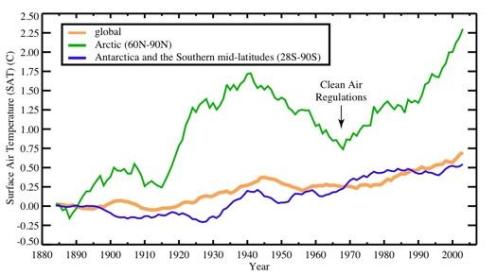March 22, 2009: “We conclude that decreasing concentrations of sulphate aerosols and increasing concentrations of black carbon have substantially contributed to rapid Arctic warming during the past three decades.” Nature Geoscience, Greg Shindell and Greg Faluvegi, “Climate response to regional radiative forcing during the twentieth century.” Graph: Drew Shindell, GISS:

2009 NASA graph shows warming of Arctic latitudes resulting from US Clean Air Acts of 1970, 1977 and 1990.
………………………………
Added: Houston Chronicle article:
April 8, 2009, “Half of recent arctic warming may not be due to greenhouse gases,“ Houston Chronicle, by Eric Berger
“According to a new report, half of the recent Arctic warming is not due to greenhouse gases, but rather clean air policies.
That’s the conclusion of two scientists in a new Nature Geoscience paper (see abstract), which is more deeply outlined in this NASA news release.
Here’s a quote from lead author Drew Shindell of the NASA Goddard Institute for Space Studies:
“There’s a tendency to think of aerosols as small players, but they’re not,” said Shindell. “Right now, in the mid-latitudes of the Northern Hemisphere and in the Arctic, the impact of aerosols is just as strong as that of the greenhouse gases.”
“We will have very little leverage over climate in the next couple of decades if we’re just looking at carbon dioxide,” Shindell said. “If we want to try to stop the Arctic summer sea ice from melting completely over the next few decades, we’re much better off looking at aerosols and ozone.”
The following graphic shows how clean air regulations passed in the 1970s have likely accelerated warming by diminishing the cooling effect of sulfates:

I probably don’t need to tell you the implications of this study.
For one, if the results are validated, the notion that global warming is causing an accelerating, headlong retreat of the Arctic sea ice and driving the polar bear to imminent death … well, these notions just aren’t wholly correct anymore.
The study suggests that as much as half of the recent Arctic melting is not due to global warming, but rather to other factors. This report does not speak to global temperatures, but rather the Northern Hemisphere. And it does not suggest that global warming has played no role in the Arctic warming.
All the same, this is potentially a huge blow to those who advocate immediate action on controlling carbon dioxide.
Finally, for those of you who hate James Hansen: Please note that the author of this study works for Hansen.” Above graph by Drew Shindell, GISS
……………………………..
Added:
George Bush #1 signs Clean Air Act amendments in 1990, making rules stricter than 1970 and 1977 versions. Top left, clapping, Bush EPA chief William Reilly, plucked from his job as WWF president by fellow America-hating oligarch Bush #1.
………………………………..
Added: From NASA.gov
April 2009: “Over the past three decades, the United States and European countries have passed a series of laws that have reduced sulfate emissions by 50 percent. While improving air quality and aiding public health, the result has been less atmospheric cooling from sulfates.…At the same time, black carbon emissions have steadily risen, largely because of increasing emissions from Asia. Black carbon — small, soot-like particles produced by industrial processes and the combustion of diesel and biofuels — absorb incoming solar radiation and have a strong warming influence on the atmosphere.”…
4/8/2009, “Aerosols May Drive a Significant Portion of Arctic Warming,” nasa.gov/topics
“Though greenhouse gases are invariably at the center of discussions about global climate change, new NASA research suggests that much of the atmospheric warming observed in the Arctic since 1976 may be due to changes in tiny airborne particles called aerosols.
Emitted by natural and human sources, aerosols can directly influence climate by reflecting or absorbing the sun’s radiation. The small particles also affect climate indirectly by seeding clouds and changing cloud properties, such as reflectivity.
A new study, led by climate scientist Drew Shindell of the NASA Goddard Institute for Space Studies, New York, used a coupled ocean-atmosphere model to investigate how sensitive different regional climates are to changes in levels of carbon dioxide, ozone, and aerosols.
The researchers found that the mid and high latitudes are especially responsive to changes in the level of aerosols. Indeed, the model suggests aerosols likely account for 45 percent or more of the warming that has occurred in the Arctic during the last three decades. The results were published in the April issue of Nature Geoscience….
Sulfates, which come primarily from the burning of coal and oil, scatter incoming solar radiation and have a net cooling effect on climate. Over the past three decades, the United States and European countries have passed a series of laws that have reduced sulfate emissions by 50 percent. While improving air quality and aiding public health, the result has been less atmospheric cooling from sulfates.
At the same time, black carbon emissions have steadily risen, largely because of increasing emissions from Asia. Black carbon — small, soot-like particles produced by industrial processes and the combustion of diesel and biofuels — absorb incoming solar radiation and have a strong warming influence on the atmosphere….
The regions of Earth that showed the strongest responses to aerosols in the model are the same regions that have witnessed the greatest real-world temperature increases since 1976. The Arctic region has seen its surface air temperatures increase by 1.5 C (2.7 F) since the mid-1970s. In the Antarctic, where aerosols play less of a role, the surface air temperature has increased about 0.35 C (0.6 F).
That makes sense, Shindell explained, because of the Arctic’s proximity to North America and Europe. The two highly industrialized regions have produced most of the world’s aerosol emissions over the last century, and some of those aerosols drift northward and collect in the Arctic. Precipitation, which normally flushes aerosols out of the atmosphere, is minimal there, so the particles remain in the air longer and have a stronger impact than in other parts of the world.
Since decreasing amounts of sulfates and increasing amounts of black carbon both encourage warming, temperature increases can be especially rapid. The build-up of aerosols also triggers positive feedback cycles that further accelerate warming as snow and ice cover retreat.
In the Antarctic, in contrast, the impact of sulfates and black carbon is minimized because of the continent’s isolation from major population centers and the emissions they produce.
“There’s a tendency to think of aerosols as small players, but they’re not,” said Shindell. “Right now, in the mid-latitudes of the Northern Hemisphere and in the Arctic, the impact of aerosols is just as strong as that of the greenhouse gases.“
The growing recognition that aerosols may play a larger climate role can have implications for policymakers. [Right, sure.]
“We will have very little leverage over climate in the next couple of decades if we’re just looking at carbon dioxide,“ Shindell said. “If we want to try to stop the Arctic summer sea ice from melting completely over the next few decades, we’re much better off looking at aerosols and ozone.”
Aerosols tend to be quite-short lived, residing in the atmosphere for just a few days or weeks. Greenhouses gases, by contrast, can persist for hundreds of years. Atmospheric chemists theorize that the climate system may be more responsive to changes in aerosol levels over the next few decades than to changes in greenhouse gas levels, which will have the more powerful effect in coming centuries.”…
…………………….
Added: July 2011 PNAS: Additional peer reviewed citation that post 1970 warming “is driven by efforts to reduce air pollution in general and acid deposition in particular:”
July 19, 2011 PNAS study in “Conclusion” notes post 1970 warming “is driven by efforts to reduce air pollution in general and acid deposition in particular, which cause sulfur emissions to decline.”
7/19/2011, “Reconciling anthropogenic climate change with observed temperature 1998–2008,” PNAS.org
………………
Comment: Don’t tell Ivanka about any of this-she might cry. As Houston Chronicle article noted, the news will be a “huge blow” to those attached to the notion that Americans must be punished with even more CO2 restrictions. These people deeply believe that punishing Americans is compassionate.
............

No comments:
Post a Comment